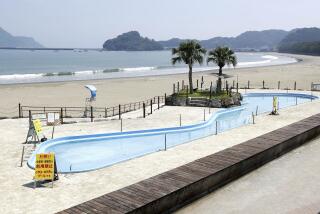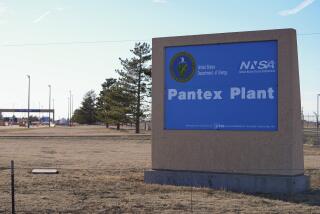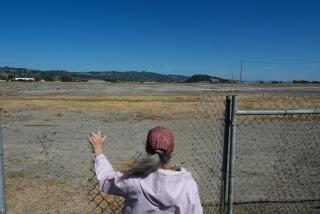Worried about radiation danger?
UCLA professor Keisuke Iwamoto answered reader questions about the dangers of radiation exposure in a live Web chat Thursday.
Iwamoto, a faculty member at UCLA’s Division of Molecular and Cellular Oncology, studies radiation exposure and how it can lead to cancer. In his research, he also has analyzed donated tissue samples from Japanese atom bomb survivors.
Here’s the transcript of the chat (moderated by L.A. Times staff writer Jeannine Stein with help from reader engagement editor Martin Beck):
Jeannine Stein: Welcome to our live Web chat on the health effects of radiation. Our guest is Keisuke Iwamoto, an adjunct associate professor of experimental radiation oncology. His research interests include how the body responds to radiation exposure and how it can lead to cancer. Welcome, Dr. Iwamoto, and thanks very much for being here today.
Kei Iwamoto: Hi everyone, thanks for being here. I hope I can answer some of your questions.
Jeannine Stein: I’ll start off by asking something that’s on a lot of people’s minds: Radioactive isotopes are headed toward California after being released from the nuclear plant in Japan. We’ve been told that there’s nothing to worry about, that the radiation levels are very low and not potentially harmful. Still, many people are worried. From what you know about this, is there any cause for alarm at this point?
Kei Iwamoto: There should be no alarm from the radiation because it will be so diluted and negligible by the time it gets here.
Comment From John: Should I buy Iodine tablets?
Kei Iwamoto: Hi John, there should be no need to buy the tablets except for nutritional purposes; i.e, you are deficient in iodine.
Jeannine Stein: Would there be side effects if people did take them without needing them?
Kei Iwamoto: There are studies that excessive iodine can be unhealthful; for example there can be allergic reactions, and in some cases it can actually cause goiter, which is ironic because deficiency is usually connected with goiter.
Comment from Joyful Diligence: What are ‘harmful levels’ of radiation in the short run and long-run? Cant even the slightest exposure to radiation require cancer in a person?
Kei Iwamoto: Hi Joyful, this is actually a complicated question. Defining a dose as high and low does not really describe the real situations. The range that we use in the radiation field generally runs from microsieverts to tens of sieverts; one sievert is a million microsieverts.
Background, from the rocks around us, the radiation from space, etc. give us about 3,000 microsieverts a year. Even pilots can get an extra 1,000 microsieverts a year from flying. The amount of radiation from Japan will be very much below the above doses I’ve just described, so the cancer risk will be negligible.
Jeannine Stein: How does the amount of radiation people may get from Japan compare to what people may be exposed to every day from flying in airplanes, getting an X-ray, etc.?
Kei Iwamoto: A medical X-ray like from a CAT scan is around 1,000 microsieverts, and the amount you might expect from Japan might be a thousand times less than that.
Comment From Concerned: I am in the very early stages of pregnancy -- 6 weeks -- living in Los Angeles. Do I need to take any precautions?
Comment From Nirav: Should pregnant woman and kids stay inside during the forecast weekend rain?. I am concerned that the radioactive materials will come down with rain.
Comment From elliot: My wife is 10 weeks pregnant. Any extra steps she should be taking?
Kei Iwamoto: The amount of radiation expected should be so negligible that there should be no effects on pregnant women and their children, in the womb or running around on the playground...
The risks from air pollution should be a greater one than that from any fallout from Japan.
Jeannine Stein: Dr. Iwamoto, is there a precedent for radiation arriving here from bombs or earlier accidents, such as Chernobyl? Do you know how much reached here? Did anything happen in terms of people’s health?
Kei Iwamoto: I do not know the exact numbers but I do know that the radiation from the 1986 accident was negligible from a health standpoint; I know of no evidence that that accident caused any increase in cancer in this country.
Comment From Dimitri: I have several retired Japanese business associates in Tokyo how hard should I encourage them to hop a plane and come stay in out guest room till all this problem is resolved one way or another.
Kei Iwamoto: The current reports for radiation levels in Tokyo suggest that they are still very low (in the microsieverts per hour range), so I doubt if there will be any health effects from the radiation...
They should be safe for the time being, staying put in familiar surroundings.
Comment From V. Swaminathan: When you say the radiaton will be diluted and negligible, can you be more specific? How solid is the science on this issue?
Kei Iwamoto: Hi V., we can do a rather simplistic calculation that gives the rough area that the radiation will be dispersed...
If we take the distance from Japan to the U.S. West Coast to be 5,000 miles and take the distance from Canada to Mexico to be about 2,000 miles, we can use some simple geometry to figure out the area of the triangle starting from Fukushima, Japan...
So that’s 5,000 x 2,000 x 0.5 gives us 5 million square miles to disperse; if we assume the area of the power plant to be around a 100th of a square mile, spread out to 5 million square miles -- that’s a dilution of at least 500 million....
So even a high dose of 1,000 microsieverts at the plant could be around a microsievert.
Comment From CA: Prof. Iwamoto, thanks for your time. It’s great being able to ask these questions directly to an expert.
Comment From Paul C: For purposes of assessing risk, how many microsieverts is fatal
Comment From Robert M: How many microsieverts would be enough to make it wise to “do something”? And by doing something in that higher level case, what would we do? Stay indoors, take something, drill 50 ft into the earth and hide out for 100 years?
Kei Iwamoto: Hi Paul and Robert, generally a whole body dose of approximately 6 million microsieverts will cause death within a few weeks. There is really no clear-cut dose boundary for these things, but you might want to become concerned if the levels get to be on the order of tens of thousands of microsieverts.
Comment From Adam: Are these amounts of radiation still neglible for longer periods of exposure? Is there a constant plume coming from Japan into the jetstream so that people will be exposed to these levels for many days/weeks? Just wondering
Kei Iwamoto: Hi Adam, you bring up a good point. In addition to dose, dose rate is important; that is, how quickly one can attain a certain dose...
For example being exposed to 1,000 microsieverts over a day is different from being exposed to [that dosage] over a second, because the cells in our body can repair the damage caused by the radiation and if the damage is accrued over a longer time, it’s easier for them to repair it...
Also, any radioactive iodine that might come has a relatively short half-life of a week or so. In a week the dose will go from negligible to half of that.
Comment From Christy: Are you saying that if radioactive material arrives on the West Coast on Friday, that cesium, strontium, and radioactive iodide will pose ZERO health risk? If small health risk, what is the risk? What about as they accumulate in our cells/DNA over time/
Kei Iwamoto: Hi Christy, certainly no risk is zero, but compared to every other form of risk that we encounter everyday, the risk would be so close to zero that zero would be a better description.
Comment From Dick: How about pets, particularly dogs that need to go outside, and particularly a young puppy? I realize you’re not a vet, but could a puppy nosing around the beach here get enough radioactive iodine to be a concern? Given their greater sensitivity and their noses on the ground, should young pups be kept inside until the levels are clear?
Jeannine Stein: Dr. Iwamoto has graciously agreed to stay on a little past 2 p.m. Pacific time to continue to answer questions, so please stay tuned!
Kei Iwamoto: Hi Dick, yes you’re right, I’m not a vet, but there should be no radiological health effects judging by what we predict to be the small amount of any radioactivity coming from Japan.
Comment From Wayne: I have a vacation in Hawaii in 2 weeks. Should I make other plans given that the reactors are still leaking radiation?
Comment From Lilia: I am participating in LA marathon on Sunday and wirily be outside for over 8 hours walking in the rain. Shall I be conserned about radiation exposure during that time?
Comment From Steve Hanson: Is it safe for young children to play outside this weekend?
Kei Iwamoto: There will be more radiation from our surroundings than what we expect from outdoor activities; just as a sort of comparison, the UV light from the sun will produce more DNA damage than any damage from radiation from Japan.
Jeannine Stein: We have another question from a reader: “Since we will have no bad affects here, why not talk about what the people in Japan working at the power plant are facing?”
Dr. Iwamoto, can you talk about what levels of exposure the nuclear power plant workers might be facing, and what their health risks may be?
Kei Iwamoto: My heart goes out to those dedicated workers and other members of the rescue team; some may be exposed to hundreds of thousands of microsieverts or greater depending on the length of time they are exposed and their positions from the source of radiation...
At the lower end of the hundreds of thousands of microsieverts, they may just experience some temporary low white blood counts...
At the millions of microsieverts some may feel nausea, and their risk for cancer may go up in the coming decades...
If anyone is unfortunate enough to be exposed to tens of millions of microsieverts, the hope to save them may be small.
Comment From Guest: kei, have you started to do anything different to protect your health since the news began?
Kei Iwamoto: No, I’m not doing anything different; we have to keep enjoying and being thankful for the life that we have here in California. Thanks, all of you, for your comments and questions.
Jeannine Stein: I’m afraid that’s all the time we have today. Thanks, everyone, for being part of our chat. Dr. Iwamoto, thank you very much for being such a great guest and for taking the time to answer our readers’ questions, we appreciate it.
Kei Iwamoto: Thank you!






